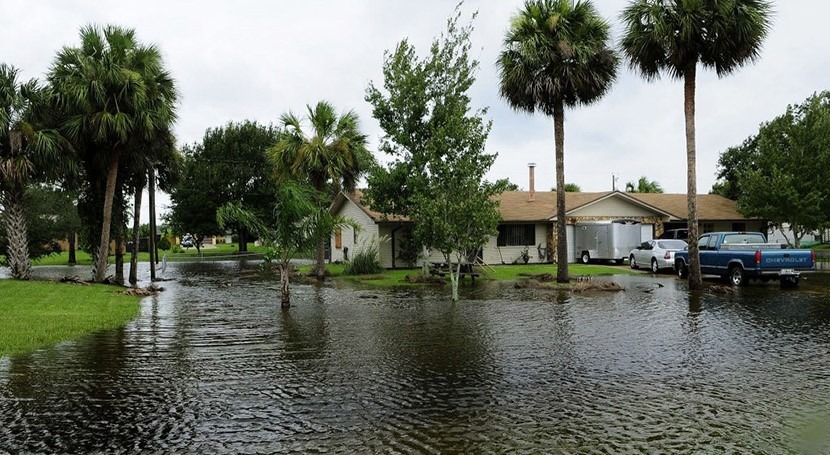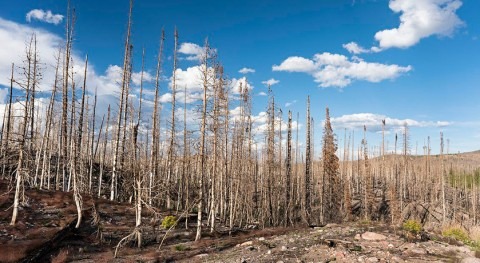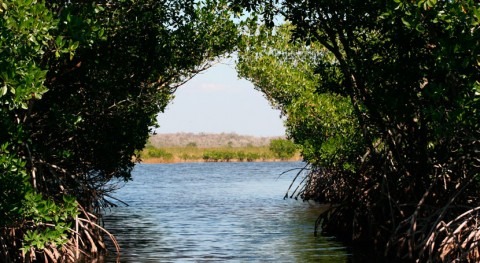Across the continental United States, massive, often-devastating precipitation events—the kind that climate scientists have long called “hundred-year storms”—could become three times more likely and 20 percent more severe by 2079, a new study projects.
That is what would happen in a scenario in which greenhouse gas emissions continue to increase at a rapid rate—what researchers call a high-warming scenario. Extreme rainfall events, the so-called hundred-year storms, would then be likely to occur once every 33 years.
The new study finds warming has a more profound effect on both the severity and frequency of extreme precipitation events than it does on common precipitation events. The research was published in AGU’s journal Earth’s Future, which publishes interdisciplinary research on the past, present and future of Earth and its inhabitants.

These images show the projected change in 100-year flood inundation areas in the Sacramento Valley in Northern California (top), the confluence of the Des Moines and Raccoon Rivers in Central Iowa (middle) and the Pearl River near Jackson, Mississippi (bottom). The dark purple areas indicate the historical flood inundation areas during a 100-year flood, and the light purple areas show what areas would flood under a high-warming scenario.
Credit: Swain et al. 2020/Earth’s Future/AGU.
The findings have serious implications for how humans prepare for the future, according to the researchers.
“The five-year flood, the 10-year flood—those aren’t the ones that cause huge amounts of damage and societal disruption,” said Daniel Swain, a climate scientist at the University of California Los Angeles and lead author of the new study. “That comes when you get 50- or 100-year floods, the low-probability but high-consequence kinds of events.”
For example, the occurrence of historic rainfall events such as the one that caused California’s Great Flood of 1862 or Houston’s flooding from Hurricane Harvey in 2017 is increasing much faster than that of lower-magnitude events that happen every decade or so.
Extreme rainfall becomes more extreme
The new study predicts extreme precipitation increases for the entire continental United States and delves into the consequences of those extreme rainfall events: the increases in the number of floods and the number of people who would be exposed to them.
Combining climate, water physics and population models, the authors project that, in a high-warming scenario, the increases in extreme precipitation alone would put up to 12 million additional people at risk of exposure to damage and destruction from catastrophic flooding — nearly 30 percent more people than face that risk today.
The new study finds warming has a more profound effect on both the severity and frequency of extreme precipitation events than it does on common precipitation events
Surging Waters, a report produced by AGU in 2019, looks at flooding in the United States and demonstrates how science is supporting flood management, as well as furthering the solutions needed to mitigate flood impacts on people and property in the future.
The new study also made projections using other scenarios that combine the effects of warming and projected population growth. For example, high warming juxtaposed with high population growth would increase the number of people exposed to risk of so-called 100-year floods by around 50 million in the continental U.S.
And even in the absence of climate change—at least some of which is unavoidable over the next 30 years—medium or large population growth would expose an additional 20 million or 34 million, respectively, to such floods, highlighting the importance of demographic factors in driving the growing risk.
“There’s a huge difference between best- and worst-case scenarios,” Swain said. “People’s exposure to flooding in a warming climate is definitely going to increase. It could increase by a somewhat manageable amount or by a truly massive amount, and that depends both on the climate trajectory we take and on the demographics of the U.S.”
More frequent flooding
Previously, projections for extreme precipitation events relied on limited historical records that go back only 100 years. For the new study, the researchers used a modeling technique to create multiple plausible pasts and futures, essentially increasing the amount of available data by 40 times over what was available from history alone.
“We don’t just have one 100-year event we can pull from the historical record; we have lots of really severe, rare events we can pull out to give us a better sense of how they’re likely to change,” Swain said.
Importantly, the study found the risk of flooding in the U.S. will increase significantly over the next 30 years, even with moderate warming—meaning a temperature increase of 1.5 to 2.5 degrees Celsius (2.7 to 4.5 degrees Fahrenheit) globally. That would expose more than 20 million additional people to a 100-year flood within the next 30 years, they projected.
Even the term “100-year flood” is probably already something of a misnomer, Swain said. With global temperatures already having increased by about 1.2 degrees Celsius (about 2.1 degrees Fahrenheit) over the past century, the term is fast becoming outdated.
James Done, a co-author of the paper and climate scientist at the National Center for Atmospheric Research, said further work is required to understand exactly why extreme events are increasing more rapidly than less extreme ones.
“It’s not just because of a shift in the distribution of the flooding,” Done said. “There’s something else that’s reshaping the most extreme of the very dangerous rainfall events.”












